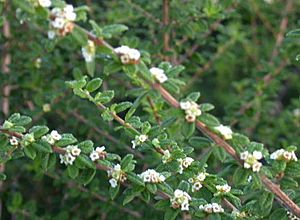Nashia inaguensis facts for kids
Quick facts for kids Nashia inaguensis |
|
|---|---|
 |
|
| Scientific classification | |
| Genus: |
Nashia
|
| Species: |
inaguensis
|
Nashia inaguensis is a special kind of evergreen shrub. It's often called Moujean tea, Bahamas berry, or pineapple verbena. This plant naturally grows on the sunny, rocky islands in the eastern Caribbean. It is especially found on Inagua island in the Bahamas. The plant's name, inaguensis, comes from this island. It likes to spread out over rocks, where it gets lots of sun but is also a bit protected from strong winds.
This shrub can grow up to 2 meters (about 6.5 feet) tall. It has many branches. Older plants can have trunks that are 5–10 centimeters (2–4 inches) wide. Its leaves have a nice smell. They are small, about 5–10 millimeters (0.2–0.4 inches) long. The leaves grow in pairs or small groups. Their edges are often curled under.
The plant has tiny white flowers. These flowers grow in small groups where the leaves meet the stem. They are about 2 millimeters (0.08 inches) long. Each flower has four small petals and four stamens (the parts that make pollen). Both the fragrant leaves and the small white flowers attract many pollinators. The Atala butterfly especially loves this plant.
Growing Moujean Tea
Nashia inaguensis is often used as a bonsai plant. This is because its small leaves and tiny flowers make it look like a miniature tree. After the flowers bloom, small reddish-orange berries appear.
This plant loves lots of sunshine and warmth. It needs a temperature of at least 5 °C (41 °F). It also needs a lot of moisture in the air, which is called high humidity. If the plant gets dry even for a short time, it can die.
You can grow new plants from cuttings. This means taking a piece of the plant and helping it grow roots. The best time to do this is in the spring and early summer. This is when the nights are warm.
Uses of Moujean Tea
The fragrant leaves of Nashia inaguensis are used to make an herbal tea. People describe the tea's smell and taste in different ways. Some say it smells like citrus fruits, while others think it smells like vanilla or pineapple. To make the tea, the leaves are steeped in hot water. This process is called making a decoction.

